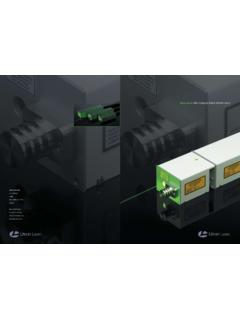Transcription of MARITIME APPLICATIONS OF LIDAR SENSORS …
1 White Paper MARITIME APPLICATIONS OF LIDAR SENSORS . FOR obstacle avoidance AND navigation . Background Projects to enable autonomous or semi-autonomous control of MARITIME vessels are underway on multiple fronts by multiple project teams. Similar to ground vehicle autonomy, MARITIME autonomy requires a blending of mission and route planning, precise craft localization, obstacle detection and avoidance , assembly, analysis and processing of all sensor inputs, and control functions. This white paper proposes a sensor to address the obstacle detection and avoidance requirement, as well as offering possibilities for localization. The required sensor must enable detection and identification of obstacles in the water at a sufficient range to perform an evasive maneuver if necessary.
2 The ability to quickly classify the object enables the control system to decide on the proper course of action. If an obstacle is moving in a trajectory that avoids intersection with the vessel, no action may be required. If an object is detected only at short range, there may be insufficient time to alter course. Using GPS alone for craft localization is notoriously unreliable. A high resolution sensor can also be of use in determining the position of known landmarks such as a coastline, buoys, or other predetermined objects and inferring craft coordinates from them. Likewise, images captured from onboard SENSORS need stabilization through an IMU or other means. A high resolution sensor with sufficient frame rate can be used to ascertain vessel pitch roll and yaw vis-a-vis observable objects.
3 Solution The Velodyne HDL-64E LIDAR sensor meets the requirements for this application. With a range of 120m, objects can be detected at sufficient range to allow for necessary action. With 64 lasers spread over a 27-degree vertical field, and that field rotating 360. degrees at a rate from 5-15 Hz, a rich and detailed point cloud of the environment is built. Each laser is a 905 nm IR laser diode that emits a short pulse that reflects off an object or is absorbed by unchurned water. The sensor reports the distance to the object along with the intensity of that return. Over million data points each second are transmitted over the Ethernet interface - orders of magnitude more data than conventional LIDAR SENSORS . The HDL-64E's lasers each emit an optical pulse that is five nanoseconds in duration, and focused using a lens.
4 When the light strikes a target, a portion of the light reflects towards the source. This return light passes through a separate lens and a UV sunlight filter. This receiver lens focuses the return light on an Avalanche Photodiode (APD), which then generates an output signal relative to the strength of the received optical signal. The laser and APD are precisely aligned at the Velodyne factory to provide maximum sensitivity while minimizing signal crosstalk, thus forming the emitter-detector pair. The return signal is digitized at over 3 GHz and analyzed via DSP for multiple returns, and intensity of each return. Output is reported in 100 mbps UDP Ethernet packets. The HDL-64E is weatherproofed for MARITIME use. With an IP67 rating and its rotating nature, casual water does not pose a risk for sensor operation.
5 The stainless steel construction helps the sensor operate well, even in salt water environments. Velodyne HDL-64E. LIDAR sensor Results Typical images from the sensor on a MARITIME vessel clearly show other vessels, structures, and coastal features. Since there is generally little return from the unchurned sea surface, obstacle detection/segmentation is simplified. Smaller floating objects such as a kayak at 50 meters are readily identified. Since the HDL-64E provides all the needed cost map data from a single sensor , no image assembly from multiple SENSORS is required, thus obstacle wire framing, identification, and other tasks can be done quite well with minimal computational cost. The sensor refreshes its image significantly faster than typical marine radar. This enables better obstacle tracking and facilitates safe operation closer to obstacles (with sufficient craft control).
6 The images from the sensor represent a 3D model which permits not only obstacle detection, but recognition, classification, and relative position as well. Size and shape of obstacles are readily apparent. Because the laser is an active light source, there are several advantages over passive vision systems. The sensor can operate at night and in various sunlight situations. The sensor provides a view of the entire 360 degree field of view around the vessel instead of a more limited field that is available from most camera systems. LIDAR image produced from the Velodyne HDL-64E showing docked boats 2. LIDAR image produced from the Velodyne HDL-64E showing docked boats. A navigable path can be easily extracted from the image. SPAWAR (US Navy) in San Diego, CA has successfully conducted various tests using the HDL-64E LIDAR sensor for an unmanned surface vessel (USV).
7 More information can be found at: Conclusion The HDL-64E is a crucial part of a perception system for MARITIME vessels for obstacle avoidance and navigation . The LIDAR can see obstacles as small as a kayak in the water at 50 meters. Larger obstacles with high reflectivity can be detected at a distance of up to 120 meters. The sensor is also used extensively for ground vehicle APPLICATIONS and was originally developed for the DARPA Grand Challenge in 2005 and was used extensively by leading teams in the 2007 DARPA Urban Challenge. Velodyne LIDAR , Inc. 345 Digital Drive w w w. v e l o d y n e l i d a r. c o m Morgan Hill, CA 95037.









